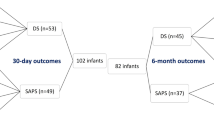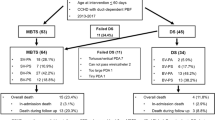Abstract
Patent ductus arteriosus (PDA) stenting is an accepted method for securing pulmonary blood flow in cyanotic neonates. In neonates with pulmonary atresia and single source ductal-dependent pulmonary blood flow (SSPBF), PDA stenting remains controversial. We sought to evaluate outcomes in neonates with SSPBF, comparing PDA stenting and surgical Blalock–Taussig shunt (BTS). Neonates with SSPBF who underwent PDA stenting or BTS at the four centers of the Congenital Catheterization Research Collaborative from January 2008 to December 2015 were retrospectively reviewed. Reintervention on the BTS or PDA stent prior to planned surgical repair served as the primary endpoint. Additional analyses of peri-procedural complications, interventions, and pulmonary artery growth were performed. A propensity score was utilized to adjust for differences in factors. Thirty-five patients with PDA stents and 156 patients with BTS were included. The cohorts had similar baseline characteristics, procedural complications, and mortality. Interstage reintervention rates were higher in the PDA stent cohort (48.6% vs. 15.4%, p < 0.001).





Similar content being viewed by others
References
Glatz AC, Petit CJ, Goldstein BH et al (2018) Comparison between patent ductus arteriosus stent and modified Blalock-Taussig shunt as palliation for infants with ductal dependent pulmonary blood flow: insights from the congenital catheterization research collaborative. Circulation 137:589–601
Bentham JR, Zava NK, Harrison WJ et al (2018) Duct stenting versus modified Blalock Taussig shunt in neonates with duct-dependent pulmonary blood flow: associations with clinical outcomes in a Multicenter National Study. Circulation 137:581–588
Goldstein BH, O’Byrne ML, Petit CJ et al (2019) Differences in cost of care by palliation strategy for infants with ductal-dependent pulmonary blood flow. Circ Cardiovasc Interv 12:e007232
Feltes TF, Bacha E, Beekman RH 3rd et al (2011) Indications for cardiac catheterization and intervention in pediatric cardiac disease: a scientific statement from the American Heart Association. Circulation 123:2607–2652
Santoro G, Capozzi G, Capogrosso C et al (2016) Pulmonary artery growth after arterial duct stenting in completely duct-dependent pulmonary circulation. Heart 102:459–464
Qureshi AM, Goldstein BH, Glatz AC et al (2019) Classification scheme for ductal morphology in cyanotic patients with ductal dependent pulmonary blood flow and association with outcomes of patent ductus arteriosus stenting. Catheter Cardiovasc Interv 93:933–943
Justino H, Petit CJ (2016) Percutaneous common carotid artery access for pediatric interventional cardiac catheterization. Circ Cardiovasc Interv 9:e003003
Petit CJ, Qureshi AM, Glatz AC et al (2019) Comprehensive comparative outcomes in children with congenital heart disease: the rationale for the Congenital Catheterization Research Collaborative. Congenit Heart Dis 14:341–349
Petit CJ, Glatz AC, Qureshi AM et al (2017) Outcomes after decompression of the right ventricle in infants with pulmonary atresia with intact ventricular septum are associated with degree of tricuspid regurgitation: results from the congenital catheterization research collaborative. Circ Cardiovasc Interv 10:e004428
Nakata S, Imai Y, Takanashi Y et al (1984) A new method for the quantitative standardization of cross-sectional areas of the pulmonary arteries in congenital heart diseases with decreased pulmonary blood flow. J Thorac Cardiovasc Surg 88:610–619
Du ZD, Hijazi ZM, Kleinman CS, Silverman NH, Larntz K, Amplatzer I (2002) Comparison between transcatheter and surgical closure of secundum atrial septal defect in children and adults: results of a multicenter nonrandomized trial. J Am Coll Cardiol 39:1836–1844
Forbes TJ, Kim DW, Du W et al (2011) Comparison of surgical, stent, and balloon angioplasty treatment of native coarctation of the aorta: an observational study by the CCISC (Congenital Cardiovascular Interventional Study Consortium). J Am Coll Cardiol 58:2664–2674
O’Connor MJ, Ravishankar C, Ballweg JA et al (2011) Early systemic-to-pulmonary artery shunt intervention in neonates with congenital heart disease. J Thorac Cardiovasc Surg 142:106–112
Lee KJ, Hinek A, Chaturvedi RR et al (2009) Rapamycin-eluting stents in the arterial duct: experimental observations in the pig model. Circulation 119:2078–2085
Alwi M, Choo KK, Latiff HA, Kandavello G, Samion H, Mulyadi MD (2004) Initial results and medium-term follow-up of stent implantation of patent ductus arteriosus in ductdependent pulmonary circulation. J Am Coll Cardiol 44:438–445
Dorobantu DM, Pandey R, Sharabiani MT et al (2016) Indications and results of systemic to pulmonary shunts: results from a national database. Eur J Cardiothorac Surg 49:1553–1563
Daubeney PE, Wang D, Delany DJ et al (2005) Pulmonary atresia with intact ventricular septum: predictors of early and medium-term outcome in a population-based study. J Thorac Cardiovasc Surg 130:1071
Dowdle SC, Human DG, Mann MD (1990) Pulmonary ventilation and perfusion abnormalities and ventilation perfusion imbalance in children with pulmonary atresia or extreme tetralogy of Fallot. J Nucl Med 31:1276–1279
Maskatia SA, Spinner JA, Morris SA, Petit CJ, Krishnamurthy R, Nutting AC (2013) Effect of branch pulmonary artery stenosis on right ventricular volume overload in patients with tetralogy of fallot after initial surgical repair. Am J Cardiol 111:1355–1360
Douglas WI, Goldberg CS, Mosca RS, Law IH, Bove EL (1999) Hemi-Fontan procedure for hypoplastic left heart syndrome: outcome and suitability for Fontan. Ann Thorac Surg 68:1361–1367 (discussion 1368)
Januszewska K, Kolcz J, Mroczek T, Procelewska M, Malec E (2005) Right ventricle-topulmonary artery shunt and modified Blalock-Taussig shunt in preparation to hemiFontan procedure in children with hypoplastic left heart syndrome. Eur J Cardiothorac Surg 27:956–961
Knott-Craig CJ, Julsrud PR, Schaff HV, Puga FJ, Danielson GK (1993) Pulmonary artery size and clinical outcome after the modified Fontan operation. Ann Thorac Surg 55:64651
Celebi A, Yucel IK, Bulut MO, Kucuk M, Balli S (2017) Stenting of the ductus arteriosus in infants with functionally univentricular heart disease and ductal-dependent pulmonary blood flow: a single-center experience. Catheter Cardiovasc Interv 89:699–708
Meadows JJ, Qureshi AM, Goldstein BH et al (2019) Comparison of outcomes at time of superior cavopulmonary connection in single ventricle infants with ductal-dependent pulmonary blood flow initially palliated with either Blalock-Taussig shunt or ductus arteriosus stent: results from the Congenital Catheterization Research Collaborative. Circ Cardiovasc Interv 10:e008110
Author information
Authors and Affiliations
Corresponding author
Ethics declarations
Conflict of interest
There are no conflicts of interest for any authors as it relates to this study.
Additional information
Publisher's Note
Springer Nature remains neutral with regard to jurisdictional claims in published maps and institutional affiliations.
Supplementary Information
Below is the link to the electronic supplementary material.
Rights and permissions
About this article
Cite this article
Bauser-Heaton, H., Qureshi, A.M., Goldstein, B.H. et al. Comparison of Patent Ductus Arteriosus Stent and Blalock–Taussig Shunt as Palliation for Neonates with Sole Source Ductal-Dependent Pulmonary Blood Flow: Results from the Congenital Catheterization Research Collaborative. Pediatr Cardiol 43, 121–131 (2022). https://doi.org/10.1007/s00246-021-02699-7
Received:
Accepted:
Published:
Issue Date:
DOI: https://doi.org/10.1007/s00246-021-02699-7




